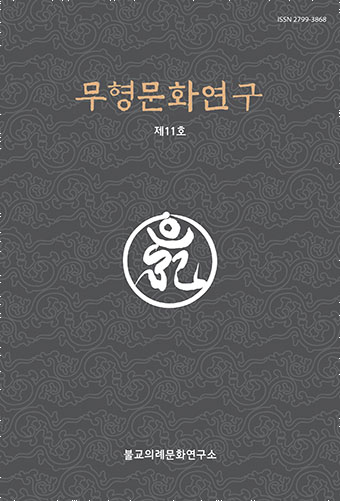해외논단
Abstract
References
Information
『두르가띠빠리쇼다나 딴뜨라』는 사후에 망자를 지옥・아귀・축생과 같은 악취로부터 벗어나기 위하여 건립하는 만다라와 관정 등 밀교의례에 대한 내용을 소개하고 있다. 또한 악취로부터 중생을 구제하기 위한 장례의식과 추선의례(追善儀禮), 구제한 중생의 장수연명을 위한 의례, 중생을 구제하기 위한 4종 호마법인 식재(息災)・증익(增益)・경애(敬愛)・항복(降伏)법을 행하는 방법을 설명하고 있다.
밀교의 관정을 수여받은 아사리는 악취에 떨어진 망자를 구제하기 위해서 만다라를 조단하고 관정을 집행한다. ‘무량수 만다라’는 연명장수를 실현함으로써 악취에 떨어지는 것을 두려워하는 범부 및 깨달음의 달성을 목표로 하는 행자 모두에게 이익을 가져오기 위한 만다라이다. ‘수명성취 만다라’는 사신(死神)을 복종시켜 생각지 못한 죽음으로부터 중생을 구제하고 연명장수를 실현하기 위한 만다라이다. ‘분노 만다라’는 중생에게 화복(禍福)을 가져오는 모든 장애마를 몰아내는 분노존 만다라이다.
아사리는 이러한 만다라를 조단하여 관정의식을 행한다. 관정의식은 아사리와 만다라를 구성하는 특정 존격의 합일을 가능하게 하며, 아사리는 존격이 가진 위력을 사용할 수 있다. 이러한 원리에 따라 아사리는 망자를 관정의 장소로 소청하여 부처의 세계인 만다라에 들어갈 수 있게 한다. 그리고 이때 망자는 부처의 자비에 의해 악취로부터 벗어나게 된다.
Durgatiparishodhana Tantra introduces the contents of esoteric Buddhist rituals such as maṇḍala and ābhiṣeka, which are built to escape the dead from the worlds of hell, hungry ghosts, and animals after death. In addition, there are funeral ceremonies and rituals for saving living beings from evil worlds, rituals for the long life of saved living beings. And It explains how to perform the four types of homa to save living beings: śāntika[息災], pauṣṭika[增益], vaśīkaraṇa[敬愛], abhicārika[降伏].
Ācārya, who has been awarded the ābhiṣeka of the esoteric Buddhism, creates a maṇḍala and performs the ābhiṣeka to save the dead who have fallen into evil worlds. ‘Infinite Life Maṇḍala’ is a maṇḍala that is intended to bring benefits to both ordinary people who are afraid of falling into evil worlds and practitioners who aim to achieve enlightenment by obtaining longevity. ‘Life Achievement Maṇḍala’ is a maṇḍala to save living beings from unexpected death and achieve long life by obeying the god of death. ‘Wrath Maṇḍala’ is an wrathful Buddha maṇḍala that drives away all the hindrance demons that bring misfortune to living beings.
Ācārya creates this maṇḍala and performs a ābhiṣeka ritual. The ābhiṣeka ritual enables the union of the ācārya and the specific buddha that make up the maṇḍala, and the ācārya can use the power of the buddha. According to this principle, ācārya invites the dead to the place of ābhiṣeka so that they can enter the maṇḍala, the world of Buddha. And at this time, the dead is freed from evil worlds by the mercy of Buddha.
- SKORUPSKI, Tadeusz, THE SARVADURGATIPARISODHANATANTRA, Delhi: 1983.
- 乾仁志(1989), 「仏説大乗観想マンダラ浄諸悪趣経について」, 『印仏研』 第三七巻 二号.
- 川﨑一洋(2001), 「チャンパ・ラカン現存の悪趣清浄マンダラについて」, 『高野山大学大学院紀要』 第五号.
- ロルフ・ギーブル(1993), 「『抜済苦難陀羅尼経』 雑考」, 『東方学』 第八六号.
- Publisher :불교의례문화연구소
- Publisher(Ko) :불교의례문화연구소
- Journal Title :Intangible Culture
- Journal Title(Ko) :무형문화연구
- Volume : 11
- No :0
- Pages :157~178


 Intangible Culture
Intangible Culture





